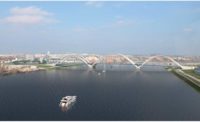Clark worked with its subcontractors for more than six weeks to develop a detailed, hour-by-hour schedule. The team mapped out the plan weeks in advance for each 50-hour window. "We broke down what was happening every 15 minutes," says Sullivan. The first time, crews got the track back up with minutes to spare. "By the sixth shutdown, we were 10 hours ahead of schedule," he adds.
Clearing the Air
Orange County, Calif., loses an estimated $20 billion per year due to traffic congestion. With an eye on transit alternatives and mixed-use development, Anaheim, which receives 20 million of the county's 40 million annual visitors, began envisioning ARTIC about two decades ago. Voters in 2006 approved an extension of a 0.5% sales-tax increase to fund projects under the jurisdiction of the Orange County Transportation Authority (OCTA). Almost half the project cost comes from that measure's extension.
Buying a 16-acre site from OCTA, the city of Anaheim began to plan a center that would link various transit users to the nearby attractions, says Emami, the city's public-works capital programs manager. "There was a lot of permitting and agreements, but everyone saw the vision and the need."
The design process went through a wrinkle, says Virginia Tanzmann, project manager for PB. "The building was going to be much larger," she says. But initial bids came in too high, so a redesign began in January 2012, with a scramble to be ready for rebids in June. "We spent an intense spring in non-stop meetings to complete the redesign documents for bidding without compromising the schedule," Tanzmann says. The much-larger footprint had been based on a projected ridership of future high-speed rail. "The solution is that we've made a place where [the high-speed-rail authority] can [someday] build a terminal for themselves, congruent with this design," Tanzmann says.
In the meantime, as of December, visitors coming off the 57 Freeway—or by bike off the trail near the Santa Ana River—will pass through a meticulously landscaped approach. "We did super-fine grading to make sure egress was as flat as possible yet allow for water drainage," says David Gal, principal with landscape architect SWA. "We did grading maps with contours that were within a tenth of a foot. We had to take into account events today and in the future—what could happen with additional transit coming into the station. It's in a key location for the city. You've got to get it done right the first time."
When visitors enter the main lobby from the north, they can head straight for bus bays and bike lockers or ascend the stairwell to a second floor of retail and restaurants. Glass cladding, maple finishes and stainless-steel trim complement the ETFE roof and terrazzo floor. A third floor functions as if it were an airport gate, with Wi-Fi, seats and more concessions. Then, it's off to the platforms for an expected 10,000 daily boardings.
"It's up, over and down," says McAlpine.












Post a comment to this article
Report Abusive Comment